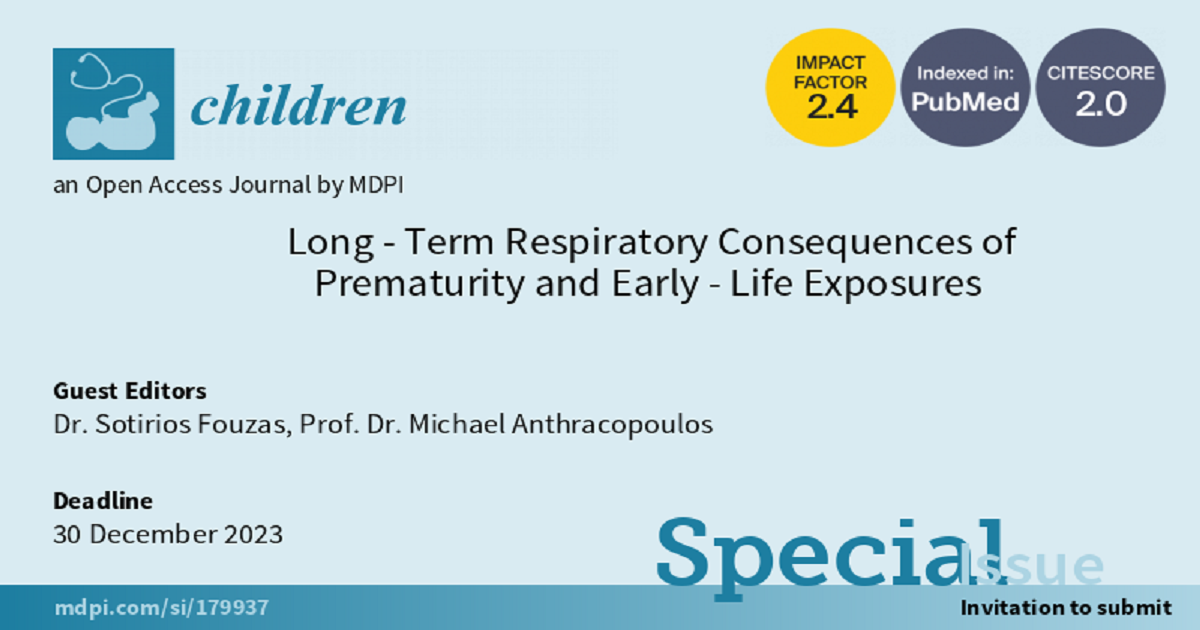Long-Term Respiratory Consequences of Prematurity and Early-Life Exposures
A special issue of Children (ISSN 2227-9067). This special issue belongs to the section "Pediatric Pulmonary and Sleep Medicine".
Deadline for manuscript submissions: closed (30 December 2023) | Viewed by 2379

Special Issue Editors
Interests: respiratory physiology; lung development; asthma; cariopulmonary exercise testing
Special Issues, Collections and Topics in MDPI journals
Special Issue Information
Dear Colleagues,
Adverse early-life events may have respiratory consequences that bleed into childhood, adolescence, or even adulthood. Preterm-born children often experience long-term respiratory morbidity, including recurrent wheezing, asthma, lung-function abnormalities, and reduced exercise capacity. Furthermore, early-life exposures, such as perinatal antibiotics, viral infections, nutritional factors, environmental pollutants, and tobacco smoke, can significantly contribute to the development and progression of various respiratory disorders.
This Special Issue aims to highlight the latest discoveries with regards to the Long-Term Respiratory Consequences of Prematurity and Early-Life Exposures. We invite submissions of original research articles, reviews, systematic reviews, meta-analyses, and perspectives exploring various aspects of this field. Potential topics of interest include, but are not limited to, (1) the epidemiology of long-term respiratory morbidity in preterm-born individuals, (2) mechanisms underlying the respiratory morbidity of premature infants in later life, (3) the impact of early-life exposures on respiratory health and disease susceptibility, (4) socioeconomic and other environmental factors that may affect long-term respiratory outcomes in such populations, (5) biomarkers and diagnostic tools for the early detection and monitoring of individuals at risk, and (6) possible interventions to improve the long-term respiratory outcomes of preterm-born infants.
Dr. Sotirios Fouzas
Prof. Dr. Michael Anthracopoulos
Guest Editors
Manuscript Submission Information
Manuscripts should be submitted online at www.mdpi.com by registering and logging in to this website. Once you are registered, click here to go to the submission form. Manuscripts can be submitted until the deadline. All submissions that pass pre-check are peer-reviewed. Accepted papers will be published continuously in the journal (as soon as accepted) and will be listed together on the special issue website. Research articles, review articles as well as short communications are invited. For planned papers, a title and short abstract (about 100 words) can be sent to the Editorial Office for announcement on this website.
Submitted manuscripts should not have been published previously, nor be under consideration for publication elsewhere (except conference proceedings papers). All manuscripts are thoroughly refereed through a single-blind peer-review process. A guide for authors and other relevant information for submission of manuscripts is available on the Instructions for Authors page. Children is an international peer-reviewed open access monthly journal published by MDPI.
Please visit the Instructions for Authors page before submitting a manuscript. The Article Processing Charge (APC) for publication in this open access journal is 2400 CHF (Swiss Francs). Submitted papers should be well formatted and use good English. Authors may use MDPI's English editing service prior to publication or during author revisions.
Keywords
- prematurity
- bronchopulmonary dysplasia
- wheezing
- asthma
- exercise capacity
- respiratory morbidity
- viral infections
- lung function
- environmental exposures
- tobacco smoke
Benefits of Publishing in a Special Issue
- Ease of navigation: Grouping papers by topic helps scholars navigate broad scope journals more efficiently.
- Greater discoverability: Special Issues support the reach and impact of scientific research. Articles in Special Issues are more discoverable and cited more frequently.
- Expansion of research network: Special Issues facilitate connections among authors, fostering scientific collaborations.
- External promotion: Articles in Special Issues are often promoted through the journal's social media, increasing their visibility.
- e-Book format: Special Issues with more than 10 articles can be published as dedicated e-books, ensuring wide and rapid dissemination.
Further information on MDPI's Special Issue polices can be found here.







